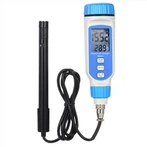How to Measure PROFIBUS Faults with Multimeter
In the absence of handheld devices and oscilloscopes, you can use a multimeter to perform some basic tests, such as testing PROFIBUS cables, bus connectors and loop impedance. These tests cannot provide 100% exact numbers, but they can provide a rough indication. At the same time, these measurements must also meet the following prerequisites:
(1) The same parts (PROFIBUS cables and plugs) must be used throughout the segment, PROFIBUS parts should not be connected, and PROFIBUS cables must be disconnected. You can determine if the cable has been disconnected by measuring the voltage between the shield and the two data wires.
(2) All terminators must be disconnected. If there are permanently connected PROFIBUS components in the system, such as repeaters, these components should be disconnected. Each segment must be measured separately.
Using a multimeter to measure can find and locate the following errors:
●Simple data line "inversion"
●One of the two data lines is interrupted
●Cable shield terminal
●Short circuit between two data lines
●Short circuit between data line and cable shield
1) Determination of loop impedance
The loop impedance is determined by measuring the impedance between the two cores of the PROFIBUS cable. The impedance of the core depends on the cable construction and is also temperature dependent. Specific cable impedance is usually specified in ohms per km (ohms) at a given temperature. It is equivalent to the loop impedance of a 1km long PROFIBUS cable. Typical values for PROFIBUS RS 485 cable type A are 110 ohm/km loop impedance at 20ºC. However, for special cables, eg highly flexible cables, deviations from this value may be possible. As the temperature rises by 1ºC, the cable impedance increases by 0.4%. Measuring the cable loop impedance is relatively simple.
At one end of the PROFIBUS cable, data core A and data core B must be short-circuited (or bridged). Then at the other end of the cable, measure the loop impedance between the two cores. In the PROFIBUS cable manufacturer's data sheet, consult the specific loop resistance (ohm/km) of the cable used. For short cables (less than 50m), the loop impedance may be zero. Using this specific loop impedance the length of this cable segment can be estimated:
Length (km) = measured loop impedance (ohms) / specific loop impedance (ohm/km):
The cable loop impedance can also be estimated from knowledge of the cable length:
Loop impedance, Rloop (ohms) = cable length (km) x specific loop impedance (ohm/km)
2) Test PROFIBUS cables and bus connectors
All stations must be disconnected from the cable and all terminators must be closed or disconnected before starting the test. The five steps described below should be done on each PROFIBUS segment. Step 1 check that the cable is free of voltage from the power supply terminator; Step 2 check for shorts between the cable wires; for steps 3 and 4, introduce a short between the selected pins in the 1st connector , and make these measurements on each of the remaining connectors. If the short circuit introduced at a connector fails, this indicates that the cable is bad or incorrectly connected. Steps 1 to 4 must be done in the correct order in measuring the cable to adequately check for errors in which the cable is not routed. Step 5 is to check this cable length by introducing a short circuit between the A and B wires on the first connector and measuring the loop impedance on the last connector.
●Step 1
Using the low DC voltage range on your multimeter, check that there is 0 voltage between the shield and connector pins A and B. If any voltage is found, either the cable is not disconnected from all equipment or still has a powered terminator.
●Step 2
Impedance is measured between connector pins on each connector. If the measured impedance is infinite (fail), then there is a short circuit or terminating resistor plugged in. For the measurement, this cable loop impedance Rloop must be evaluated. This can be accomplished as previously described. Locating a short circuit on a PROFIBUS cable can be difficult because a fault in just one connector will short the entire cable. One solution is to isolate sections of the cable until the short circuit disappears. But it must be noted that the connected terminal resistor will introduce an impedance of 220Ω between the A line and the B line. Proceed to step 3 only if no short circuits are found and all terminators are disconnected.
●Step 3
A short circuit must be introduced between pin 8 (wire A) on the first connector of the segment under test and the shield during the test. In the 1st connector, introduce a link from pin 8 to the shield to complete the short circuit. These measurements are then made on every other connector.
●Step 4
A short circuit must be introduced between pin 3 (wire B) on the 1st connector of the segment under test and the shield for the measurement. In the 1st connector, introduce a link from pin 3 to the shield to complete the short circuit. These measurements are then made on every other connector.
●Step 5
The cable loop impedance is measured by introducing a short circuit between pin 3 (B wire) and pin 8 (A wire) during the measurement. The short circuit is accomplished by introducing a link between pin 3 and pin 8 in the first connector. Then, measure the loop impedance between pin 3 (wire B) and pin 8 (wire A) on the last connector.






